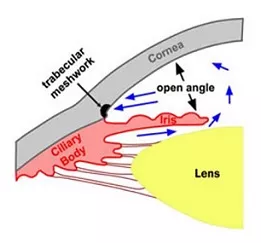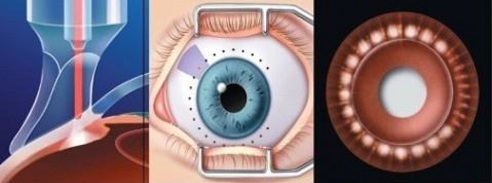Why is cyclodiode laser necessary?
Cyclodiode laser is performed for patients with glaucoma or high eye pressure.

Fluid in the eye (aqueous) is produced by the ciliary body, and drains out through the trabecular meshwork (drainage pathway) in the drainage angle. Sometimes the trabecular meshwork no longer copes, preventing aqueous from draining out easily. This causes pressure to build up in the eyeball. When the pressure in the eye is too high, it can cause optic nerve damage and permanent vision loss – this is called glaucoma.
Doing the laser reduces the eye pressure, which in turn reduces the risk of further optic nerve damage from glaucoma.
Cyclodiode laser is traditionally reserved for eyes that already have poor vision or are painful due to high eye pressures.
However, it is increasingly performed earlier when the eye pressure remains high despite using eye drops, particularly if glaucoma surgery is too risky.
See Related:
Surgical treatments for glaucoma
What does cyclodiode laser do?
The laser causes thermal damage to the ciliary body. This reduces the amount of aqueous produced, and effectively “turns off the tap”, leading to decreased eye pressure. The effect of the laser is not immediate, and can take up to 2 to 3 weeks to become apparent.
Cyclodiode laser works successfully in approximately 80%. However, the effects of laser treatment can wear off over time, so you may need another treatment within 18 months. Sometimes, the effect may last for months or years.
The treatment can be repeated if necessary, or other treatment may be offered if appropriate.

See Related:
Trabeculectomy surgery for glaucoma
Drainage tube shunt surgery for glaucoma
What are the potential risks?
Cyclodiode laser is generally safe. Most complications can be treated although sight-threatening complications may occur rarely (less than 1 in every 1000). Risks include:
● Scratch on the front window of the eye (cornea).
● Persistent inflammation in the eye.
● Damage to the lens (resulting in a cataract). This can be treated with
cataract surgery.
● May not work and the pressure may stay high.
● May work too well and the pressure drops too low.
● Persistent pain inside the eyeball.
● Loss of vision. This is rare.
● Persistent inflammation in the fellow eye (sympathetic ophthalmia).
See Related: Risks and complications of glaucoma surgery
What should I expect?
Cyclodiode laser is a hospital-based day case procedure performed under local anesthetic.
Before laser:
Prior to the day of your procedure, please take all your usual medications unless otherwise advised. You will need to fast for at least 6 hours before your procedure.
You will not be able to drive home on the day of the procedure, so you will need to arrange for someone to take you home. Please expect to be at the hospital for at least 2 to 3 hours.
Before the laser procedure, you will receive the following:
● Cannula inserted into a vein, usually at the back of your hand.
● Local anaesthetic eye drops prior to the anesthetic injection.
● Local anesthetic injection into the eye socket to fully numb the eye.
During laser:
The laser is delivered through a special probe that is placed on the surface of the eye.
Pulses of laser energy pass through the wall of the eye (sclera) to reach the surface of the ciliary body, causing small burns. The laser itself takes around 10 minutes to perform. Usually the 270 to 360 degrees of the ciliary body is treated.
You will be awake during the laser. As your eye is fully anesthetised, you should not feel any pain. However if you feel discomfort or pain, additional local anesthetic can be given.
At the end of the procedure, a steroid injection is administered, causing a little sting.
After laser:
After laser treatment, a pad will be placed over your eye. This pad can be removed the next day, and you can recommence your usual glaucoma eye drops (if any) after laser treatment.
In addition, you will be given a steroid anti-inflammatory eye drop (usually Dexamethasone or Prednisolone) to use 4 times daily for 1 to 2 weeks.
Over the next few days, you may experience pain, discomfort, blurriness, sensitivity to light, and blood around the eye. This will gradually improve with the eye drops. You may take paracetamol to help control any pain.
You will usually be reviewed 1 to 2 weeks after laser.
See Related:


